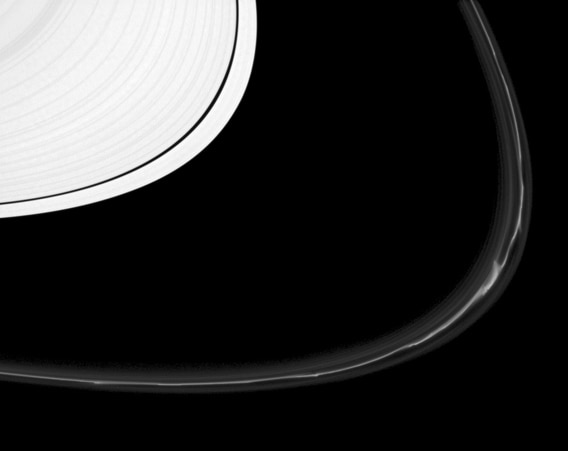Create a free profile to get unlimited access to exclusive videos, sweepstakes, and more!
Saturn Gets Kinky

The first time you see Saturnâs rings through a telescope is amazing. It can change your lifeâliterally, as it did for me when I was a wee lad.
The rings are shocking through a big telescope. Even through a small one you can see them clearly, and with a big one you can start to see some details, like the big Cassini Division, a dark gap slicing the main ring system in two.
But thereâs nothing like being there. The Cassini spacecraft (named after the Italian astronomer Giovanni Cassini, who discovered his eponymous division) has been orbiting Saturn since 2004. A masterwork of engineering, Cassini has returned thousands upon thousands of incredible images, showing amazing details in the rings.
On Dec. 25, 2012, from a distance of 1.1 million kilometers (680,000 miles), it took this phenomenal shot of Saturnâs outer rings:
Saturn is off the frame to the upper left in this picture. Cassini was just over the plane of the rings, looking at them from a shallow angle. The Sun is shining down on them, so they look very bright.
The main A ring is to the upper left, and you can see the Keeler gap, a narrow (40 km/25 mile) empty region in the rings, where the ice particles that make up the rings have been swept clear by the gravity of the tiny moon Daphnis.
But the star of this show is the weird F ring (the rings were named in order of discovery, not distance from Saturn). To give you a sense of scale, the division between the A and F rings is about 3000 km (1800 miles), roughly the distance from New York City to Denver, Colorado.
The ring is narrow, and thatâs no accident. Orbiting just inside and outside of it are two very small moons named Prometheus and Pandora, and they act as shepherds, constraining the ice particles into that narrow strand. Due to the vagaries of orbital mechanics, most of the particles that stray outward or inward from the ring are gently nudged back into it by the moonsâ gravity.
Both moons have orbits that are slightly elliptical and slightly tipped with respect to the rings. That means, as they orbit, they move toward and away from the F ring, Prometheus more than Pandora. As it moves toward the ring, Prometheusâs gravity drags material away from it, creating those fans and kinks in the ring, as well as the faint spiral pattern of material inside the ring. Oddly, even though it does pull some of the material out of the ring, the overall effect of Prometheus is to keep the particles inside the ring. The interaction is complex and somewhat counterintuitive, but this video put out by NASA might help.Â
The F ring is constantly changing, sometimes on a scale of just hours. Saturn is a huge, fiendishly complex system, and we knew it would be weird when we got there, but I donât think anyone suspected just how weird it would be. And we discovered all this because we sent a probe there that could stay there, orbiting the planet over and again, looking at as much as it can over as long a period of time as it can. Long-term visits are far, far better than a single fly-by (though they are critical as well!), because we learn how things behave over time. And everything changes over time. Thatâs why we need to make sure that when we visit other places, other worlds, we do so with the plans to go there and stay. Itâs the only way we can learn over the long run.


























